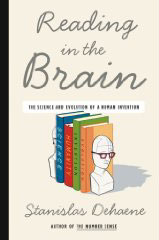 An extremely interesting new book by Stanislas Dehaene entitled Reading in the Brain: The Science and Evolution of a Human Invention has just been released. Dehaene, a neuroscientist, is curious about exactly what happens in the brain when we read, a subject of much conjecture but previous little evidence until now. My copy’s still on its way, but an interview with Scientific American‘s Gareth Cook makes it sound like Dehaene’s book will be essential for anyone thinking about how we read in new environments:
An extremely interesting new book by Stanislas Dehaene entitled Reading in the Brain: The Science and Evolution of a Human Invention has just been released. Dehaene, a neuroscientist, is curious about exactly what happens in the brain when we read, a subject of much conjecture but previous little evidence until now. My copy’s still on its way, but an interview with Scientific American‘s Gareth Cook makes it sound like Dehaene’s book will be essential for anyone thinking about how we read in new environments:
DEHAENE: One of my long-time interests concerns how the human brain is changed by education and culture. Learning to read seems to be one of the more important changes that we impose to our children’s brain. The impact that it has on us is tantalizing. It raises very fundamental issues of how the brain and culture interact.
As I started to do experimental research in this domain, using the different tools at my disposal (from behavior to patients, fMRI, event-related potentials, and even intracranial electrodes), I was struck that we always found the same areas involved in the reading process. I began to wonder how it was even possible that our brain could adapt to reading, given it obviously never evolved for that purpose. The search for an answer resulted in this book. And, in the end, reading forces us to propose a very different view of the relationship between culture and the brain.
COOK: What is this “new relationship”?
DEHAENE: A classical, although often implicit, view in social science is that the human brain, unlike that of other animals, is a learning machine which can adapt to essentially any novel cultural task, however complex. We humans would be liberated from our past instincts and free to invent entirely new cultural forms.
What I am proposing is that the human brain is a much more constrained organ than we think, and that it places strong limits on the range of possible cultural forms. Essentially, the brain did not evolve for culture, but culture evolved to be learnable by the brain. Through its cultural inventions, humanity constantly searched for specific niches in the brain, wherever there is a space of plasticity that can be exploited to “recycle” a brain area and put it to a novel use. Reading, mathematics, tool use, music, religious systems – all might be viewed as instances of cortical recycling.
Of course, this view of culture as a constrained “lego” game isn’t that novel. It is deeply related to the structuralist view of anthropology, as exemplified by Claude Lévi-Strauss and Dan Sperber. What I am proposing is that the universal structures that recur across cultures are, in fact, ultimately traceable to specific brain systems.
